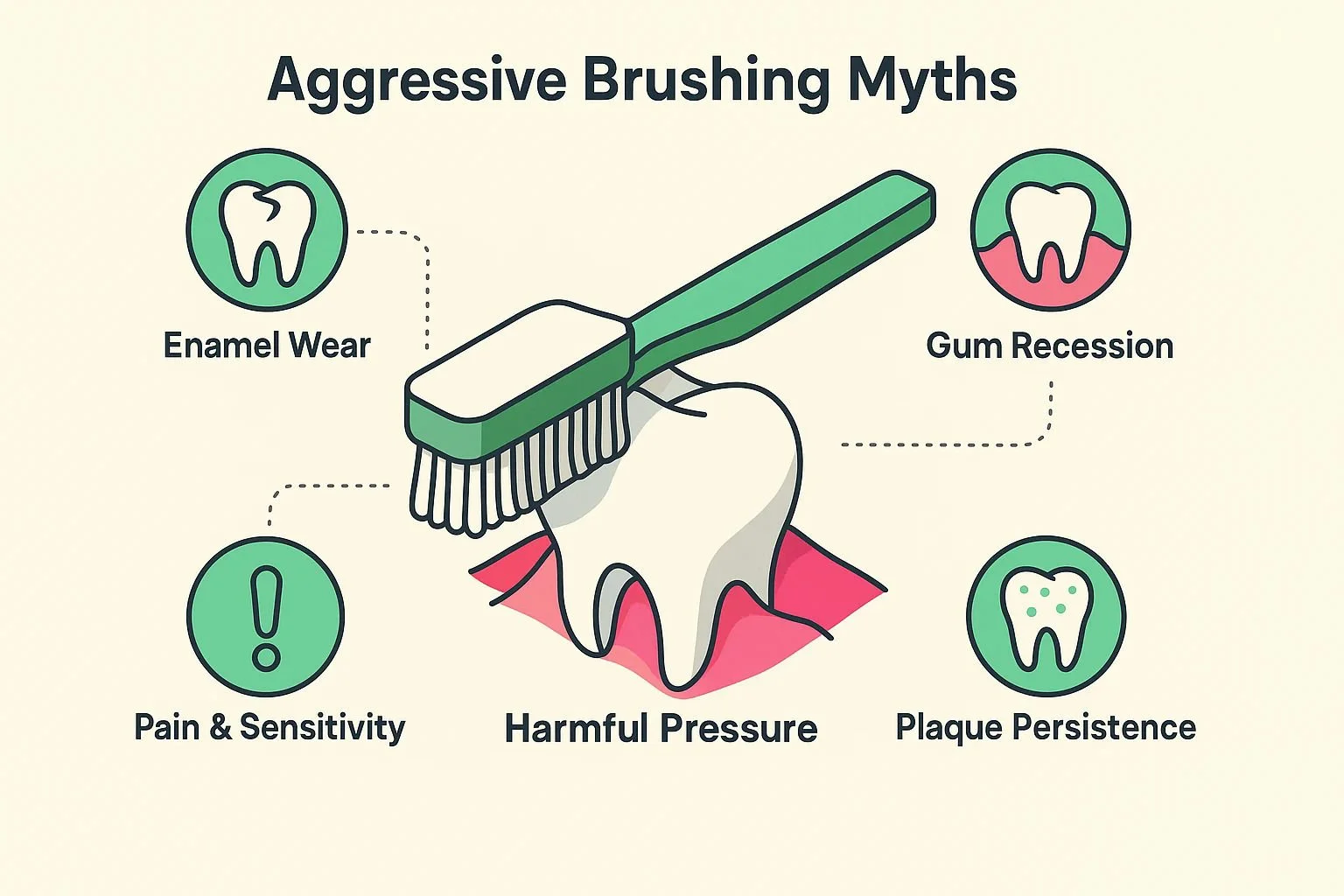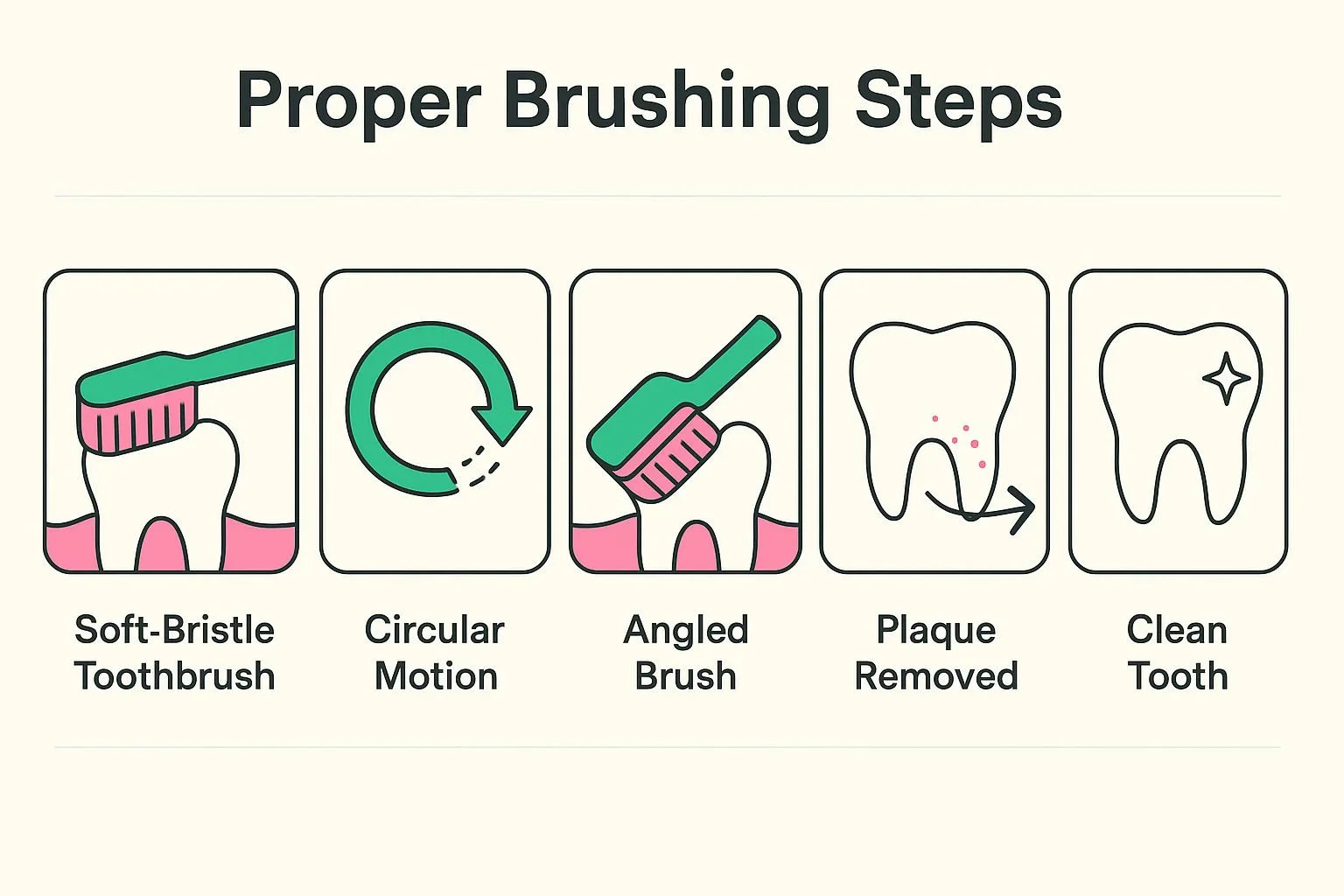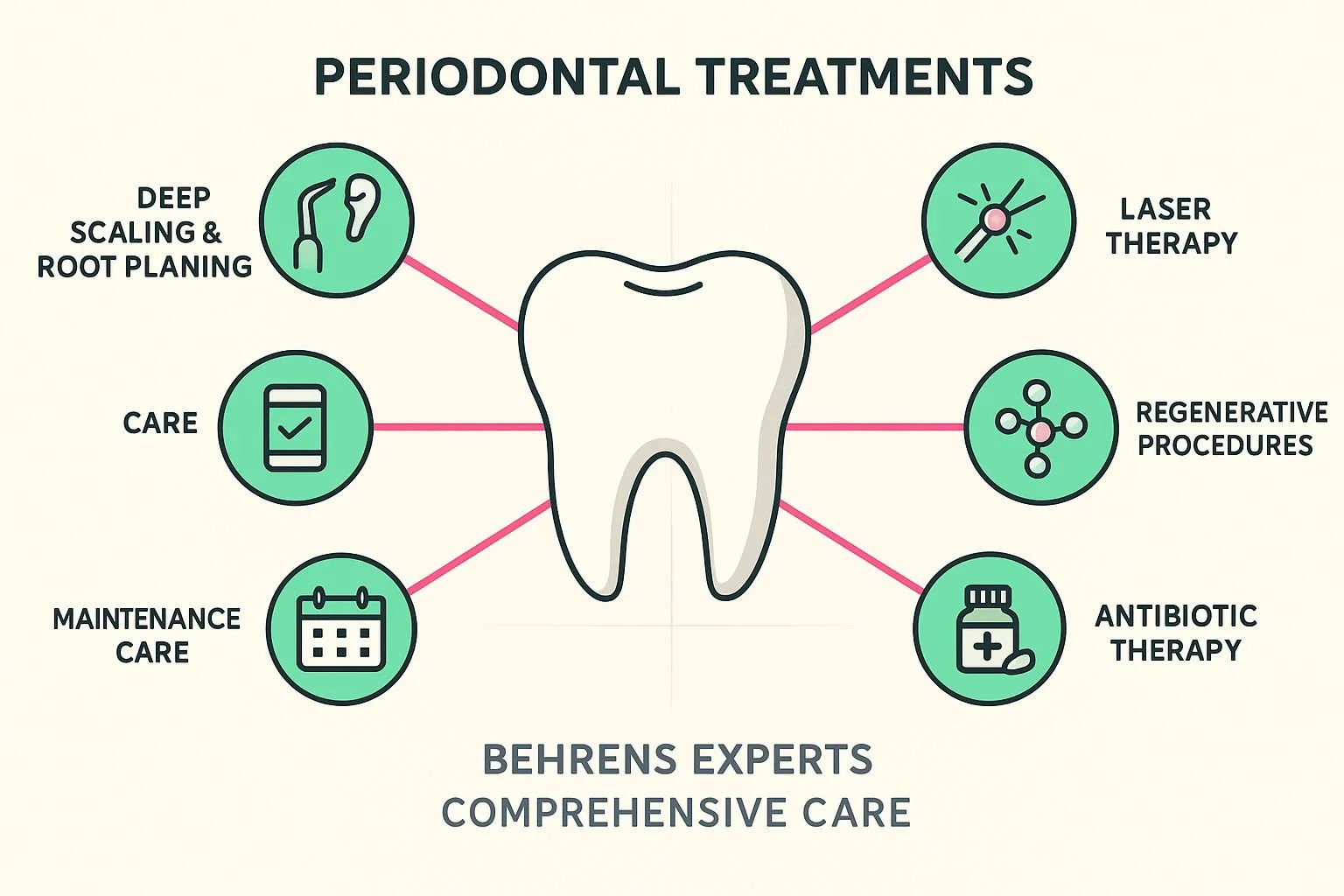Can Aggressive Brushing Cure Gum Disease? Why Technique Matters More Than Force
You see a bit of pink in the sink after brushing and your first instinct kicks in: you’re not cleaning well enough. So, the next time, you apply a little more pressure. You scrub with more vigour, determined to eliminate the problem at its source. It’s a common reaction, rooted in the idea that more force equals a better clean. But this is one of many common gum disease beliefs that can, counterintuitively, do more harm than good.
The truth is, you can’t scrub your way out of gum disease. In fact, aggressive brushing can worsen the very condition you’re trying to fix, leading to a cycle of damage that at-home care simply can’t reverse. The real solution isn’t about force; it’s about finesse, understanding, and knowing when to seek professional help.
This visual debunks the myth that aggressive brushing cures gum disease by illustrating key damages caused such as enamel wear and gum recession.
The Unseen Damage: How Brushing Too Hard Hurts Your Gums
Imagine trying to clean a delicate silk shirt by scrubbing it with a stiff-bristled brush. You might remove the stain, but you’d damage the fabric in the process. Your gums are just as delicate. When you brush too aggressively, you’re not just fighting bacteria; you’re attacking your own healthy tissue.
This mechanical trauma can lead to several problems:
Gum Recession: This is where the gum tissue pulls away from the tooth, exposing the sensitive root surface. Receding gums don’t grow back, and they create pockets where harmful bacteria can hide and thrive, accelerating gum disease.
Enamel Abrasion: The hard, protective outer layer of your teeth is called enamel. While it’s the hardest substance in the human body, it’s not invincible. Aggressive brushing, especially with a hard-bristled brush, can physically wear it away over time, leading to sensitivity and an increased risk of cavities.
Increased Sensitivity: As your gums recede and enamel thins, the underlying dentin—a more porous layer filled with tiny tubes that connect to the tooth's nerve—becomes exposed. This is why you might feel a sharp twinge of pain when consuming hot, cold, or sweet foods and drinks.
Instead of solving the problem, brushing with excessive force creates an environment where gum disease can more easily take hold and advance.
What You're Actually Fighting: A Film of Bacteria, Not Stains
The primary cause of gum disease is plaque—a soft, sticky, and colourless film of bacteria that constantly forms on your teeth. When it’s not removed effectively, it hardens into tartar (or calculus), a crusty deposit that can only be removed by a dental professional.
This bacterial buildup triggers an inflammatory response in your gums. In the early stages, this is known as gingivitis, characterised by red, swollen gums that may bleed easily. The good news is that gingivitis is often reversible with consistent, proper oral hygiene and professional cleanings.
However, if left untreated, it can progress to periodontitis, a more serious form of gum disease where the inflammation spreads below the gum line. The body’s own immune system, in its fight against the bacteria, starts to break down the bone and connective tissue that hold teeth in place. As the disease advances to a state like periodontitis stage 3, the pockets between the gums and teeth deepen, bone loss occurs, and teeth can become loose or even fall out.
The goal of brushing isn’t to scour your teeth until they shine; it’s to gently and systematically disrupt and remove the soft plaque film before it has a chance to do damage.
Step-by-step guide to proper brushing technique emphasizing gentle, effective plaque removal to protect gums.
The Right Way to Brush: A Simple Guide to Gentle Cleaning
Effective brushing is about smart technique, not brute strength. Most dental professionals recommend a method that is gentle on the gums while being tough on plaque.
Here’s how to do it right:
Choose the Right Tool: Always use a toothbrush with soft bristles. Hard bristles are too abrasive for your gums and enamel. Whether manual or electric, the key is soft bristles.
Position the Brush Correctly: Place your toothbrush against the teeth at a 45-degree angle to the gum line. This allows the bristles to reach just below the gum line, where plaque accumulates most.
Use Gentle, Short Strokes: Move the brush back and forth in short, tooth-wide strokes or use a gentle circular motion. Think of it as massaging your gums, not scrubbing them.
Be Thorough: Brush the outer, inner, and chewing surfaces of all your teeth. Spend about two minutes on the entire process to ensure you’ve covered every area.
Don’t Forget Your Tongue: Brushing your tongue helps remove bacteria and freshen your breath.
Remember, the goal is to be methodical and gentle. If your toothbrush bristles are splayed and worn out after only a few weeks, it's a clear sign you’re brushing too hard.
When Brushing Isn't Enough: The Limits of At-Home Care
Perfect brushing technique is your best defence against the onset of gum disease. However, once the disease has progressed beyond its earliest stages, no amount of brushing or flossing at home can cure it.
Why? Because periodontitis creates deep pockets between your teeth and gums that your toothbrush bristles simply cannot reach. These pockets become reservoirs for aggressive bacteria. Furthermore, once plaque hardens into tartar, it acts as a rough surface that attracts even more plaque, and it cannot be brushed away.
This is where professional intervention becomes essential. At The Behrens Dental Practice, the first step isn’t just to look at the symptoms; it’s to understand the precise cause. We conduct a microbiological test to identify the specific types of bacteria driving the disease in your mouth. This diagnostic approach allows for a highly targeted treatment plan, moving beyond a one-size-fits-all solution.
Overview of professional gum disease treatments offered by Behrens Dental Practice, highlighting comprehensive care options.
Professional Pathways to Healthy Gums
If you have established gum disease, your dentist has a range of tools and techniques to halt its progression and restore your oral health. Standard treatments often include deep cleaning procedures like scaling and root planing to remove tartar and plaque from below the gum line.
For more advanced cases, innovative, non-invasive therapies offer a powerful alternative to traditional surgery. The team at Behrens Dental, including experienced dentists with a special interest in periodontics like Dr Lior Burg, utilises advanced technology to combat gum disease effectively. An innovative duo laser treatment protocol can precisely target and eliminate harmful bacteria deep within the gum pockets while simultaneously stimulating your body's natural healing and regeneration processes.
This unique therapy, known as Duo Lase, is a minimally invasive approach that avoids the cutting and sutures associated with conventional gum surgery, leading to greater comfort and a faster recovery. It directly addresses the bacterial root of the problem, with a reported success rate of over 99% in saving teeth that might otherwise be lost.
Frequently Asked Questions (FAQ)
What kind of toothbrush is best?
The best toothbrush is one with soft bristles that fits your mouth comfortably. Both manual and electric toothbrushes can be effective if used correctly. Many people find electric toothbrushes make it easier to brush gently and for the recommended two minutes.
If my gums bleed, should I stop brushing that area?
No, you should not stop. Bleeding is a sign of inflammation caused by plaque buildup. While you should be extra gentle, it's crucial to continue cleaning the area to remove the bacteria that are causing the problem. If the bleeding persists for more than a week, it’s a clear signal to see your dentist.
How often should I replace my toothbrush?
You should replace your toothbrush (or the head of your electric toothbrush) approximately every three to four months, or sooner if the bristles become frayed. A worn-out toothbrush cannot clean your teeth effectively.
Can mouthwash cure gum disease?
Mouthwash can be a helpful addition to your oral hygiene routine by helping to reduce bacteria, but it cannot cure gum disease on its own. It does not remove plaque and tartar the way brushing, flossing, and professional cleanings do. Think of it as a supplement, not a substitute.
Your Next Step: From Awareness to Action
The most important takeaway is this: healthy gums don’t require force, they require care. Swapping aggressive scrubbing for a gentle, thorough technique is the first and most critical step you can take at home to protect your oral health.
Take a moment to assess your own habits. Are your bristles splayed? Are your gums sore after brushing? Do you rush through the process? A simple change in technique today can prevent significant problems tomorrow.
And if you’re already dealing with persistent symptoms like bleeding gums, bad breath, or loose teeth, remember that you are not alone and effective solutions are available. The most powerful step you can take is to seek a professional evaluation. A comprehensive check-up can identify the root cause of your issues and set you on a path to truly healthy gums and a confident smile.



